III. QUALITY TEST RESULTS
A. Grade Factors
The U.S. Department of Agriculture’s Federal Grain Inspection Service (FGIS) has established numerical grades, definitions and standards for measurement of many quality attributes. The attributes which determine the numerical grades for corn are test weight, broken corn and foreign material (BCFM), total damage, and heat damage. The table for “U.S. Corn Grades and Grade Requirements” is provided on page 52 of this report.
SUMMARY: GRADE FACTORS AND MOISTURE
- Although U.S. Aggregate average test weight in 2014 (57.6 lb/bu or 74.2 kg/hl) was lower than in 2013, 2012, and 3YA, it was still above the limit for No. 1 grade corn (56 lb/bu or 72.08 kg/hl).
- U.S. Aggregate average test weight was above the minimum for No. 1 grade in all ECAs.
- U.S. Aggregate average BCFM in 2014 (0.8% consisting primarily of broken corn) was less than in 2013 (0.9%) and for 3YA (0.9%) and well below the maximum for No. 1 grade (2%). Low BCFM indicates minimal cleaning required for corn delivered to first handler and should facilitate good aeration airflow during storage.
- BCFM levels in almost all (98.4%) of the corn samples were at or below the maximum of 3% allowed for No. 2 grade.
- Average BCFM, BC, and FM differed little among the three ECAs.
- U.S. Aggregate average total damage in 2014 (1.7%) was significantly higher than in previous years, which may be due in part to the delayed harvest in 2014 compared to previous years but still below the limit for No. 1 grade (2.0%). Most of the samples (83.8%) contained 3% or less damaged kernels, indicating that the corn should have good quality and store well.
- The relatively wide range of total damage between minimum and maximum values (with 5.3% of the samples containing more than 5% total damage) may require special attention to segregation when drying and storing.
- Total damage levels were highest in the Gulf ECA (2.2%) and lowest in the Pacific Northwest ECA (0.4%). The high level of total damage in the Gulf ECA may have been related to weather conditions prior to harvest, a delayed harvest, and the lower potential for field drying in the Gulf ECA.
- Total damage was consistently higher in the Gulf ECA than in the other two ECAs for 2014, 2013, and 2012.
- No heat damage was reported on any of the samples.
- Of the inbound elevator samples, 88.2% would grade No. 2 or better on all grade determining factors. Most elevators use No. 2 grade criteria as the base for pricing and discounts in domestic transactions. As corn moves through the market channel, subsequent handling, drying, and storage may lower the quality.
- U.S. Aggregate average moisture content (16.6%) was significantly lower than 2013 (17.3%) but higher than 2012 and 3YA. The wide range with higher maximum values may require more segregation by moisture content, and careful attention to drying and storage practices. More drying will be required for the 37.5% of corn containing more than 17%.
- Elevator moistures were consistently higher in the Gulf ECA than in the other two ECAs for 2014, 2013, 2012 and 3YA, which was likely due in part to comparatively lower potential for field drying in many parts of the Gulf ECA.
- The larger range in moisture contents may require more segregation by moisture content.
- Drying at the point of first delivery may result in additional stress cracking and breakage as the corn moves to export.
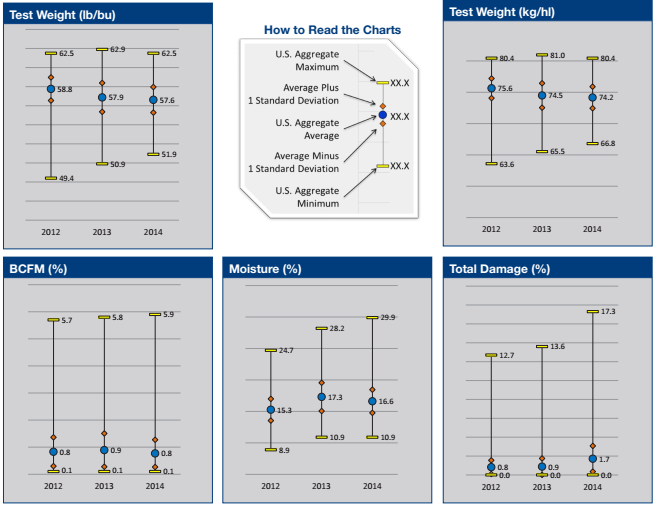
1. Test Weight
Test weight (weight per volume) is a measure of bulk density and is often used as a general indicator of overall quality and as a gauge of endosperm hardness for alkaline cookers and dry millers. High test weight corn will take up less storage space than the same weight of corn with a lower test weight. Test weight is initially impacted by genetic differences in the structure of the kernel. However, it is also affected by moisture content, method of drying, physical damage to the kernel (broken kernels and scuffed surfaces), foreign material in the sample, kernel size, stress during the growing season, and microbiological damage. When sampled and measured at the point of delivery from the farm at a given moisture content, high test weight generally indicates high quality, high percent of horneous (or hard) endosperm and sound, clean corn. Test weight is highly correlated with true density and reflects kernel hardness and kernel maturity.
RESULTS
- U.S. Aggregate average test weight in 2014 was 57.6 lb/bu (74.2 kg/hl) compared to 57.9 lb/bu (74.5 kg/ hl) in 2013 and 58.8 lb/bu (75.6 kg/hl) in 2012.
- While the 2014 U.S. Aggregate average test weight was below 3YA of 58.2 lb/bu, (75.0 kg/hl), it was still above the minimum for No. 1 grade (56 lb/bu).
- Sample values were more uniform in the 2014 crop relative to 2013, as indicated by the lower U.S. Aggregate standard deviation (1.34 lb/bu). Standard deviation for 2013 was 1.51 lb/bu.
- The range in values was also smaller among 2014 samples – 10.6 lb/bu in 2014 compared to 12.0 lb/ bu and 13.1 lb/bu in 2013 and 2012, respectively.
- The 2014 test weight values were distributed with 77.4% of the samples at or above the factor limit for No. 1 grade (56 lb/bu) compared to 81.5% in 2013. In the 2014 crop, 94.7% of the samples were above the limit for No. 2 grade, compared to 93% in 2013.
- Average test weight for each ECA was also above the limit for No. 1 grade. The Gulf and Southern Rail ECAs had the highest average test weights, 57.8 lb/bu and 58.0 lb/bu, respectively. The Pacific Northwest ECA’s lower test weight (56.6 lb/bu) occurred in 2013 and 3YA.
- The Pacific Northwest ECA also had the highest standard deviation (1.36 lb/bu) compared to the Gulf (1.34 lb/bu) and Southern Rail (1.30 lb/bu) ECAs. The lower test weight in the Pacific Northwest was accompanied by greater variability.
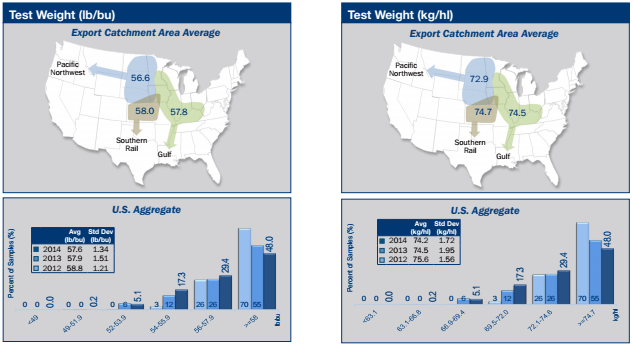
2. Broken Corn and Foreign Material (BCFM)
Broken corn and foreign material (BCFM) is an indicator of the amount of clean, sound corn available for feed and processing. The lower the percentage of BCFM, the less foreign material and/or fewer broken kernels are in a sample. Higher levels of BCFM in farm-originated samples generally stem from combine settings and/or weed seeds in the field. BCFM levels will normally increase during drying and handling, depending on the methods used and the soundness of the kernels. Increased stress cracks at harvest will also result in an increase in broken kernels and BCFM during subsequent handling.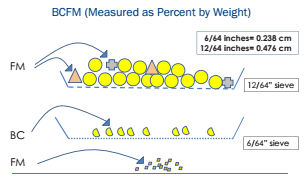
Broken corn is defined as corn and any other material small enough to pass through a 12/64th-inch round-hole sieve, but too large to pass through a 6/64th-inch round-hole sieve.
Foreign material is defined as any non-corn material too large to pass through a 12/64th-inch round-hole sieve, in addition to all fine material small enough to pass through a 6/64th-inch round-hole sieve.
The diagram to the right illustrates the procedure for measuring the factor of broken corn and foreign material for the U.S. corn grades.
RESULTS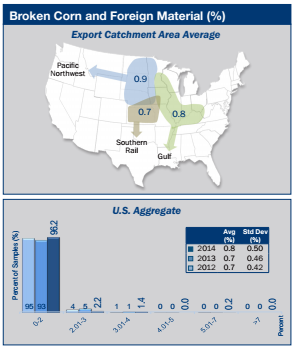
- U.S. Aggregate average BCFM in the 2014 crop (0.8%) was less than in 2013 (0.9%), and 3YA (0.9%), well below the maximum for No. 1 grade (2.0%).
- The 2014 crop was more uniform in BCFM than 3YA and previous years’ crops as indicated by standard deviations (0.50% for 2014 crop and 0.60% for 3YA). The range between minimum and maximum values was very similar for the three years.
- The 2014 samples were distributed with 96.2% of the samples below the maximum for No. 1 grade, with BCFM 2% or less, compared to 93% and 95% in 2013 and 2012, respectively.
- Average BCFM among the ECAs differed little from the U.S. Aggregate average and 3YA. BCFM varied by no more than 0.2 percentage points among the ECAs.
3. Broken Corn
Broken corn in U.S. grades is based on particle size and usually includes a small percent of non-corn material. Broken corn is more subject to mold and insect damage than whole kernels, and it can cause problems in handling and processing. When not spread or stirred in a storage bin, broken corn tends to stay in the center of the bin while whole kernels are likely to gravitate outward to the edges. The center area in which broken corn tends to accumulate is known as a “spoutline.” If desired, the spoutline can be reduced by drawing this grain out of the center of the bin.
RESULTS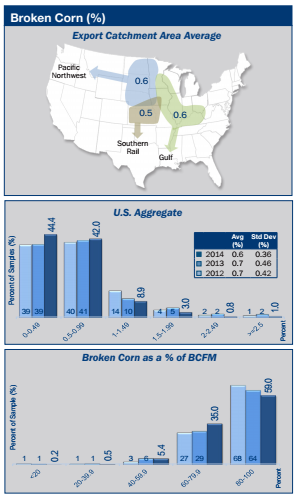
- Broken corn in the U.S. Aggregate samples averaged 0.6% in the 2014 crop, slightly lower than the levels in 2013, 2012 and for 3YA (all 0.7%).
- The 2014 crop was more uniform on the factor of broken corn than the previous two crops, with a U.S. Aggregate standard deviation of 0.36% compared to 0.46% in 2013 and 0.42% in 2012. The range between minimum and maximum values in 2014 was also smaller than in 2013 and 2012.
- The 2014 samples were distributed with 44.4% of the samples less than 0.5% broken corn and 86.4% less than 1.0% broken corn, indicating more samples with low levels of breakage than in previous years.
- The distribution chart to the right, displaying broken corn as a percent of BCFM, shows that in nearly all samples, BCFM consisted primarily of broken corn, as was found in previous years.
- The percent of broken corn in the three ECAs differed by less than 0.1 percentage point.
4. Foreign Material
Foreign material is of importance because it has little feed or processing value. It is also generally higher in moisture content than the corn and therefore creates a potential for deterioration of corn quality during storage. Foreign material also contributes to the spoutline and has the possibility of creating more quality problems than broken corn because of the higher moisture level, as mentioned above.
RESULTS
- Foreign material in the U.S. Aggregate samples averaged 0.2% in 2014, the same as in 2013 and 2012 and for 3YA.
- Variability among the U.S. Aggregate samples in 2014 was lower than in 2013, with a standard deviation of 0.19% compared to 0.23% in 2013, 0.18% in 2012 and 0.20% for 3YA.
- In the 2014 crop, 94.4% of the samples contained less than 0.5% foreign material, slightly higher than in 2013 but similar to 2012.
- All ECAs had average foreign material values equal to 0.2%.
5. Total Damage
Total damage is the percentage of kernels and pieces of kernels that are visually damaged in some way, including damage from heat, frost, insects, sprouting, disease, weather, ground, germ, and mold. Most of these types of damage result in some sort of discoloration or change in kernel texture. Damage does not include broken pieces of grain that are otherwise normal in appearance. Mold damage is usually associated with higher moisture content and high temperature in growing and/or storage.
Mold damage and the associated potential for mycotoxins is the damage factor of greatest concern. Mold damage can occur prior to harvest as well as during temporary storage at high moisture and high temperature levels before delivery.
RESULTS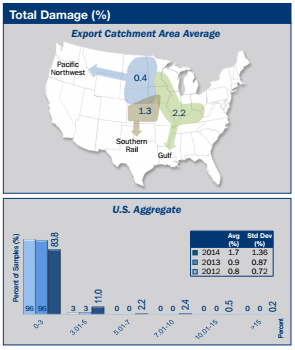
- Total damage in the U.S. Aggregate samples averaged 1.7% in 2014, significantly higher than 2013 (0.9%). Although much higher than 3YA (0.9%), 2014 total damage was still well below the limit for No. 1 grade (3%). Total damage may have been higher in part due to delayed harvest in 2014 compared to previous years.
- Total damage levels were more variable among samples in the 2014 crop than in previous years, with higher U.S. Aggregate standard deviation (1.36% compared to 0.84% for 3YA), and a wider range between minimum and maximum values (minimum value of 0 across all three years and a maximum value of 17.3% in 2014 compared to 13.6% and 12.7% in 2013 and 2012, respectively).
- Total damage in the 2014 samples was distributed with 83.8% of the samples having 3% or less damaged kernels, and 94.8% having 5% or less.
- Average total damage in the Gulf ECA was 2.2%. Moisture may have been a contributing factor since the Gulf had the highest average moisture (16.9%) and the sample with the highest maximum moisture (29.9%). The Pacific Northwest ECA had the lowest total damage (0.4%). The higher damage and higher average moistures found in the Gulf ECA may have been due in part to weather conditions that provided a lower potential for field drying in the Gulf ECA.
- Average total damage values in all ECAs were well below the limit for U.S. No. 1 corn (3.0%), but individual samples as high as 17.3% will require special attention to prevent further deterioration in storage and shipment as this corn moves through the market channel.
6. Heat Damage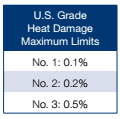
Heat damage is a subset of total damage and has separate allowances in the U.S. Grade standards. Heat damage can be caused by microbiological activity in warm, moist grain or by high heat applied during drying. Heat damage is seldom present in corn delivered at harvest directly from farms.
RESULTS
- There was no heat damage reported in any of the samples, the same results as in 2013 and 2012.
- The absence of heat damage likely was due in part to fresh samples coming directly from farm to elevator with minimal prior drying.
